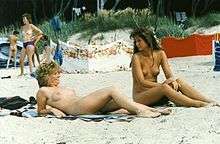Naturism in Germany
Naturism is a cultural and political movement practicing, advocating and defending social nudity in private and in public. It is particularly strong in Germany where it goes under the name Freikörperkultur. It refers to a lifestyle based on personal, family and/or social nudism.[1][2] Naturism grew out of the German Lebensreform movement and the Wandervogel youth movement of 1896, and has been adopted in many neighbouring European countries and was taken by the German diaspora to North America and other continents. In 1974, the International Naturist Federation (INF) defined naturism as:
- Naturism is a lifestyle in harmony with nature, expressed through personal and social nudity, and characterised by self-respect of people with different opinions and of the environment.[1]
History
.jpg)
German naturism was part of the Lebensreform movement and the Wandervogel youth movement of 1896, from Steglitz, Berlin which promoted ideas of fitness and vigour. At the same time doctors of the Natural Healing Movement were using heliotherapy, treating diseases such as TB, rheumatism and scrofula with exposure to sunlight.[3]
The Nacktkultur refers to a network of over 200 private clubs in Germany which promote nudism as a way of connecting the individual to nature. The term was coined in 1902 by Heinrich Pudor, who published a 3-volume treatise in 1906 connecting nudism, vegetarianism and social reform. However, its roots might go back as far as the 1870s.[4] Its major promoters were Adolf Koch and Hans Suren. Germany published the first journal of nudism between 1902 and 1932.[5]
The movement went on to gain prominence in the 1920s, portrayed as both health giving but also for its Utopian ideals. It became politicised by radical socialists who believed it would lead to a breaking down of society and classlessness. It became associated with pacificism.[6] In 1926, Adolf Koch established a school of nudism encouraging a mixing of the sexes, open air exercises, as part of a programme of "sexual hygiene". In 1929, the Berlin school hosted the first International Congress on Nudity.[4]
During the National Socialist Gleichschaltung era, naturism both benefited from official recognition and sponsorship for its health benefits, and was persecuted as officials argued over the concept of Nacktkultur. In March 1933, Prussian Minister of the Interior Hermann Göring passed laws limiting mixed sex nudism, as a reaction to the increasing immorality of the Weimar state. In January 1934, Reichmeister for the Interior, Wilhelm Frick passed edicts restricting naturism due to fears that it was a breeding ground for Marxists and homosexuals .
Reichmeister Frick's ban lasted one month. Within a year nudism was being practised with full state support again.[7] However, prohibition did not mean the end of nudism and supporters including even SS leaders. The rules were eventually softened in July 1942.[8] Nevertheless, all naturism clubs had to register with Kraft durch Freude, which meant excluding Jews and Communists. Also, they had to keep all activities well out in the countryside so there would be virtually no chance of being seen by others.

After the war, East Germans were free to practice nudism, chiefly at beaches rather than clubs (private organizations being regarded as potentially subversive by the government). Nudists became a large element in German Left Wing Politics. The Proletarische Freikörperkulturbewegung subsection of the Workers Sports Organisation had 60 000 members.[3] In the West Germany, and today, united Germany there are many clubs, parks and beaches open to naturists.[1] Since reunification, however, nudity has become less common in the former eastern zone. Vacationing in Mediterranean France at the large Cap d'Agde resort also became popular for Germans when it opened in the late 1960s, and Germans are typically the most commonly seen foreigners at nude beaches all around Europe.[9]
Facilities
There are 147 naturist/FKK clubs in Germany, with a further 14 affiliated clubs in Kärnten, Austria,[10] along with a plethora of official beaches, and FKK zones in city parks.[11] For instance, the Englischer Garten in Munich has two large areas on the banks of the Eisbach, between the city centre and the university.[12]
Nacktwandern
Organised naked rambling is very popular.[13][14]
Ohne kleid und ohne schuh, wanderne nackt in alle ruh
References
Footnotes
Citations
- 1 2 3 Choin, Mireille; Internationale Naturisten Federatie (2002). Wereldgids naturisme 2002-2003 [World naturist handbook 2002-2003] (in Dutch) (26 ed.). Diegem, Belgium: Wolters Kluwer. ISBN 978-90-5583-833-2. OCLC 66965885.
- ↑ "INF-FNI International Naturist Federation". Hörsching, Austria: International Naturist Federation.
- 1 2 Anderson, Howard, Why be a naturist: A brief history of modern naturism, archived from the original on 5 January 2009, retrieved 24 April 2012
- 1 2 Empire of ecstasy: nudity and movement in German body culture, 1910-1935 By Karl Eric Toepfer
- ↑ Homosexuality and Male Bonding in Pre-Nazi Germany by Hubert Kennedy. 1992
- ↑ The cult of health and beauty in Germany: a social history, 1890-1930 by Michael Hau
- ↑ Naked Germany: health, race and the nation by Chad Ross
- ↑ Freikörperkultur Geschichte
- ↑ "amadelio.de". Retrieved 2/12/2007. Check date values in:
|access-date=(help) - ↑ Naturist Club Addresses
- ↑ Nacktbaden Free beaches
- ↑ "FKK in München und Umland - das Nacktbaden Special" (in German). www.ganz-muenchen.de 2002-2013. 2013. Retrieved 12 February 2014.
- ↑ FKK-Nacktwandern (Naked Rambling)
- ↑ "Nackt durch die Natur". Märkische Allgemeine (in German). Verlagsgesellschaft Madsack GmbH & Co. KG. 08-07-2013. Retrieved 12 February 2014. Check date values in:
|date=(help)
Bibliography
- Choin, Mireille; Internationale Naturisten Federatie (2002). Wereldgids naturisme 2002-2003 [World naturist handbook 2002-2003] (in Dutch) (26 ed.). Diegem, Belgium: Wolters Kluwer. ISBN 978-90-5583-833-2. OCLC 66965885.
External links
- German Naturist Federation DFK homepage
- International Naturist Federation INF homepage
- German Naturist Federation Youth Section fkk-jugend e.V. homepage